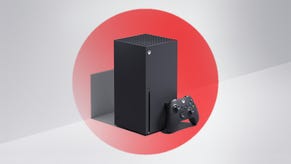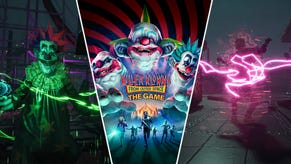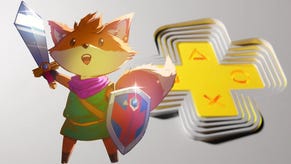Half-Life: Alyx Behind the Scenes, Part 1: How Valve Found Its New Alyx
Writer Erik Wolpaw and designer Chris Remo on casting characters old and new, Campo Santo's influence, and more.
This article first appeared on USgamer, a partner publication of VG247. Some content, such as this article, has been migrated to VG247 for posterity after USgamer's closure - but it has not been edited or further vetted by the VG247 team.
Today marks the release of Half-Life: Alyx, a virtual reality-exclusive title and the series' first installment in over 12 years. This being Valve's first full-length single-player game in close to a decade, on top of being a Half-Life title, means this is the first time that some relatively recent hires have had a chance to make their mark. It's also the chance for some longtime Valve employees to take on a more significant role in Half-Life.
Half-Life: Alyx was in development at Valve for about four years, during which Erik Wolpaw and Chris Remo were only around for about half of the time. Wolpaw, who joined Valve as a writer in the mid-2000s, left the company shortly after the earliest VR experiments that led to Half-Life's return got under way. Remo and his comrades from Campo Santo—the developers of Firewatch—all joined Valve in 2018, when Alyx was well into production. Wolpaw then came back to Valve as a contractor later that year.
Remo, a designer and programmer on Alyx, remembers playing the original Half-Life games as a fan; Wolpaw helped out on the Half-Life 2 Episodes, but those were still mainly the domain of original series writer Marc Laidlaw (Wolpaw also, of course, wrote for Portal and Left 4 Dead). Half-Life: Alyx is Remo's first Half-Life game as a developer, and it's the first time a team has taken over from Laidlaw, who announced his retirement from Valve in 2016. Wolpaw, Jay Pinkerton, and Campo Santo's Sean Vanaman worked out Alyx's story together.
In the past year, Remo says Half-Life: Alyx has become "almost a whole new game." USgamer had the opportunity to chat with Remo and Wolpaw ahead of Alyx's release. In this installment, we talk broadly about coming back to Half-Life, designing for VR, and the fate of other projects like Double Fine's Psychonauts 2 (which Wolpaw wrote for) and Campo Santo's on-hiatus In the Valley of Gods.
Wolpaw came back to Valve to help give Half-Life: Alyx a story to fit the rough progression of levels Valve had worked out, but he's still a contractor who mostly works from home. On Skype, Wolpaw calls in from his office in Cleveland, Ohio while Remo connects from Valve's headquarters in Bellevue, Washington. "I've been working on Alyx, it's been basically full-time," Wolpaw explains. "I come down to Valve every five weeks or so for ten days to two weeks—but not in the last few weeks, because of the apocalypse and whatnot."
The video call is actually a workaround, as USgamer and other websites were initially invited to send staff out to Valve's offices for a review event and interview opportunities. The coronavirus pandemic forced a change of plans. For Wolpaw, though, working from home is sort of the norm, and a few days prior to our call, he tweeted about completing a full playthrough of Alyx. In the lead up to release, most of the Alyx team and other Valve employees were playing through the game, trying to catch any game-breaking bugs. Remo says that while it's all hands on deck for bug-catchers, it felt far calmer in comparison to the launches he's experienced in the past, even with a pandemic brewing in the background.
"This has been the calmest closing out of a game development cycle I've ever experienced, by far," says Remo. "[There's a] stepped process where each discipline gets successfully closed down. The calmness with which, as each discipline moves off and the people from that discipline move into testing and looking for major issues, has happened in such a bizarrely calm way. It's very shocking for me to experience. It's extremely unlike most game development ship periods I've experienced previously."
Wolpaw adds a joke he heard from designer Robin Walker: "Robin mentioned yesterday that it took 13 years, so we work about 10 minutes a day."

Bringing Back Half-Life Without "Playing 'Freebird' Every Night"
The reveal trailer for Half-Life: Alyx released last year featured the game's two main characters: Alyx Vance and Russell, her scientist ally and over-the-radio companion voiced by Flight of the Conchords' Rhys Darby. While players first met Alyx in 2004's Half-Life 2, making it a prequel while introducing a new character in Russell struck some fans as an odd move, especially considering Half-Life 2: Episode Two's big cliffhanger.
Wolpaw says, prequel or not, the team sees this as a chance to expand the Half-Life world, especially with a new character. "We figured if that scientist on that headset was Kleiner—if we just brought back every single character, it makes the universe seem so tiny," Wolpaw says. "We didn't know Rhys personally, but we thought his voice would be nice. We wanted some warm sounding voices, because especially in VR, you're going to be going through some fairly grim environments."
Darby wasn't familiar with the Half-Life series prior to joining up (though his kids were), but Wolpaw says that he naturally gravitated toward some material and helped shape Russell's character. "The thing that always happens is, you write some stuff, you go in and record with the actor, they have some ideas, and you kind of learn what sounds better when they say it," says Wolpaw. "Russell got more interested in kind of pressing Alyx on trying different things, like touching things or being curious about what a headcrab tastes like. Rhys really responded to those types of things."
Half-Life: Alyx is also the introduction of a new voice actress for its lead character: Ozioma Akagha (Mirror's Edge: Catalyst, Marvel's Runaways) plays a younger Alyx in place of Merle Dandridge, who originated the role. In a Reddit AMA, Wolpaw noted that Valve would still like to work with Dandridge again in the future. As for casting a younger Alyx, he's a bit shocked the casting sheet didn't leak.
"They go out wide, they're everywhere," Wolpaw says. After a few weeks of listening to auditions, Akagha rose to the top. "[Ozioma's] voice was similar to what I had in my head of what a 19-year-old Alyx would sound like, and you're always going in kind-of hoping for the best. You never know. You can be about as sure as you can be until you get in the studio, and then she worked out great. [...] Unlike casting Rhys, it's an existing character, so you want to try and capture something that's true to the character."
Voices aside, as someone with years of experience doing music and audio for games, Remo has thoughts on how Half-Life: Alyx sonically captures the series' spirit without resorting to a nostalgia overload. "So much from those games is extremely memorable, and definitive when it comes to their worlds," he says. "It would almost be criminal not to hang on to that stuff and use it. [...] By the same token, you don't want to over-do it, because then you're sort of playing 'Freebird' every night.
"You want that stuff to be almost on a really slow, slow drip feed, where sometimes you get a little drop of it and it just feels amazing. It's good work, in the first place, right—it's good music and good sounds, so they're doing good work in terms of having the correct emotional effect—but then your brain, as a player, is also doing a ton of work on top that, with all the sense memory you have associated with that."
Remo says that also extends to City 17's setting and visuals, helped no doubt by many fans' intimate familiarity with certain props and textures from hours spent in Garry's Mod. "A lot of people online, when we started putting out footage in the form of the first trailer and the gameplay trailers, would say 'oh there's the van from Half-Life 2, but it looks really new and better now.'"
"Eating Our Own Dog Food" for the Sake of a Better Game
Though Valve brought in external playtesters during development, Remo and Wolpaw say Half-Life: Alyx has been greatly helped by the tuning, testing, and QA efforts of others throughout the company.
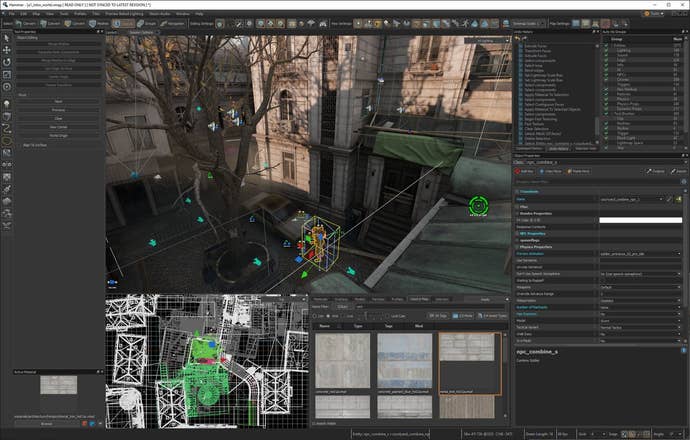
"The game has been largely complete in terms of being able to play it from beginning to end for about a year now, but what's happened over that year, it's almost a whole new game even though the core level track is very, very similar," Remo explains. "It's all because of that playtesting, both externally and also people at the studio just eating our own dog food, playing the game constantly and figuring out what's too much." Throughout development, Valve had to figure out what was "too much" for VR, for pacing, and especially for Half-Life: Alyx's horror elements in order to make the experience feel "as good as possible for as many people as possible."
Again, Wolpaw and Remo note that finishing touches like adding support for one-handed play and a Barnacle lift toggle option didn't conflict with Valve's measured wind-down of development.
"Nobody's adding anything major, especially because at some point you lock it down," Wolpaw says. "Adding or removing a line of dialogue doesn't really affect [performance], but the big last step of pretty much any shipping game is, the big brain engineers come in and make sure the game runs in perf."
"I Would Love to Do More"
When Campo Santo was acquired by Valve in 2018, the team announced it would keep working on In the Valley of Gods, its planned follow-up to the kind of first-person storytelling the team embarked on with Firewatch. Shortly after Half-Life: Alyx was revealed, it came to light that Remo and others had moved to Alyx while In the Valley of Gods was put on indefinite hold. Remo says it's possible that Valve will revisit the project in some form or another, but it doesn't sound like it's necessarily the first thing the Campo folks will jump on.

"I guess we'll see," says Remo. "We've been pretty focused on not just getting [Alyx] out the door, but there are people from the former Campo Santo team that are working on a bunch of different projects here at Valve." The team that was working on In the Valley of Gods is now spread across the company, but Remo says "you never know" how on-hiatus Valve projects may resurface: "From what I can tell, at Valve there are a lot of projects that have sort of gone dormant, been resurrected in some other form, [or] ended up worming their way into other projects."
Some of the Campo team went on to work on Dota Underlords, including Remo, who did a stint on the auto chess spin-off between periods of work on Half-Life: Alyx. "Then there are people who've done work on Steam as well," he adds. "I believe, now, a couple people are doing some work on Dota 2, particularly the run up to The International.
"Valve is a game developer, but it's also Steam, it's hardware, it's big international esports events, it's video productions, so the number of different things you can be involved in and the kinds of things you can be involved in—the different disciplines you can work in and learn new skills in—is really high," Remo says. He also vouches that he's not alone amongst former Campo members who've been able to apply their talents across multiple areas at Valve.
For Wolpaw, who's been busy contracting on Half-Life: Alyx for the past 18 months, Valve is where most of his energy has been directed of late. After his departure from the company in 2017, he signed on to do work on Double Fine's Psychonauts 2, but he's not been involved with that project for a while.
"Some of that went out the window a little bit when they got bought by Microsoft, so I haven't heard a whole lot since then," Wolpaw says. "I did some work early on and I don't know... I don't actually know what's going on there at the moment. I mean, I know they're working on it, but I think maybe my involvement ended—unless I hear from Tim [Schafer] again—when they got bought. Which is just as well, because this kind of fell into my lap a little bit and ended up being a ton of work in a year and a half."
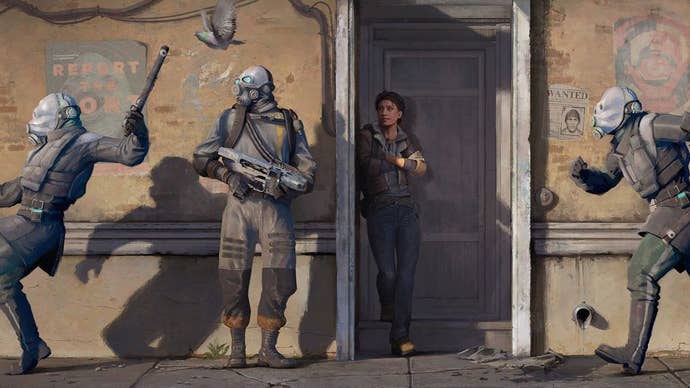
This could be just the beginning of a new Half-Life renaissance. Others at Valve have already publicly expressed their own interest in doing more, and Wolpaw is also on board: "I'm a contractor, so I'm not in the decision making process, but I will say, straight up, no hedging: I would love to do more. I want to do more. Mail it straight to Gabe—I am ready. I wouldn't have thought, you know; this was a daunting task when we came on, and I feel good about it. I mean, we'll see. It's going to come out in a week, and maybe I'm gonna regret everything, but at the moment I feel really good about what we did, and I would like to keep going."
"I think the sense that Erik describes is actually pretty commonly shared here," says Remo. As he tells it, there are plenty of people at Valve who like working in Half-Life's world and want to do more. "It's so interesting coming to this company and being surrounded by people, some of whom have joined the company after I got here, and some people that literally worked on Half-Life 1, and the sensation of everyone working on this thing together is 'oh yeah, we actually really like doing this.'"
We'll have more from our interview with Remo and Wolpaw later this week as part of our breakdown of Half-Life: Alyx's ending. Be sure to read our review, go over our spoiler-lite easter egg roundup, and read Wolpaw's recommendations of things to read, play, and watch before starting up Alyx (if you're not already booting it up).




